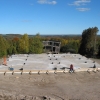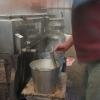Extreme Cold
With temperatures dipping down to -30C (-22F) at night (colder with the windchill), we’ve had a pretty frigid couple of weeks. It’s cold enough that the dog’s paws hurt when we go for walks, cold enough that the oil froze in the pipe between my neighbour’s oil tank and his furnace, and cold enough that one of the hoses in our generator froze solid; one of eight the shop had seen that week with the same problem.
So how does the house behave when it’s his cold? Pretty well I’m pleased to report. If the sun is out the front part of the house will get up to 25C (77F) during the day and will hold most of that heat until we go to bed. Of course with the quantity of glass we have across the front of the house we do bleed heat, and the colder it is the faster that heat goes.
If there is no sun though the floor works pretty well. It can hold the house comfortably around 20C-21C (68F-70F), trying to go any higher seems a waste of propane, we just wear sweaters. Because the way radiant floor systems work it’s a ‘slow heat’. The slab is heated to a certain temperature and from there it just radiates (obviously). But we have a huge interior volume of air, much greater than most houses of the same size because we have such high ceilings. At its lowest point our ceiling is over ten feet high, at it’s highest it’s around seventeen. The floor just cannot react fast enough to compensate when the sun goes down. As a result we’ve moved a fireplace up to near top spot on the wish-list. We built a re-enforced pad into the floor to carry the weight of a masonry fireplace but have decided that what we need is actually just an airtight insert or a good woodstove. We need something that can heat the air quickly, but can also stop relatively quickly. The last thing we want is to light a fire on a cloudy morning in a masonry heater, than have the sun come out and have the stove radiating heat all day long. We’d cook ourselves out of the house!
I’ve been running around with the caulking gun sealing cracks and hunting for drafts, and there have been lots. At this point I have gone through more than three dozen tubes of caulking and I have one piece of advice for those building a house: the expensive caulk is worth it! Buy the best stuff you can find, we’ve used various grades around the house and we’ve had all sorts of failures wherever we used cheaper caulk. It might cost more up front but it’s worth it to save the aggravation and cost of having to do the same job twice.


















































